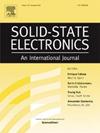A review of hafnium-based ferroelectrics for advanced computing
IF 1.4
4区 物理与天体物理
Q3 ENGINEERING, ELECTRICAL & ELECTRONIC
引用次数: 0
Abstract
In the era of data-centric computing, the quantity of data is expected to increase exponentially. The physical separation of memory and processing units in traditional computers results in a considerable amount of unnecessary energy loss and time delay in the process of data calculation and storage. Devices based on ferroelectric materials possess the advantage of integrated data storage and computing. Nevertheless, research in the field of advanced computing has been constrained due to the incompatibility of traditional ferroelectrics (e.g., perovskites) with complementary metal oxide semiconductor (CMOS) technology and poor scalability. In recent years, research and innovation in hafnium (Hf)-based ferroelectrics have reignited interest in this field. The inherent CMOS compatibility, high coercive field (Ec), and high energy band gap of Hf-based ferroelectrics make their devices highly suitable for data storage. Moreover, the negative capacitance field-effect transistor (NCFET) based on Hf-based ferroelectrics can be utilized as a representative logic computing device. In addition, the multi-level weights of biological synapses can be accurately simulated by adjusting the controllable multi-domain polarization switching in Hf-based ferroelectric films, which indicates that Hf-based ferroelectrics will also have general advantages in the field of neuromorphic computing. However, the basic mechanisms and research progress of Hf-based ferroelectrics in these advanced computing fields have not been systematically summarized and sorted out. In this paper, we summarize the latest research results of Hf-based ferroelectrics in advanced computing. We review the history of ferroelectric materials and the numerous advantages of Hf-based ferroelectrics, focusing on the working principles, research progress, and circuit applications of Hf-based ferroelectric logic and memory devices. Additionally, we review the basic concepts of neuromorphic computing, especially discussing the research progress of Hf-based ferroelectric neuromorphic devices and the circuit applications of hardware neural networks. Finally, we made a positive outlook on this field.
求助全文
约1分钟内获得全文
求助全文
来源期刊

Solid-state Electronics
物理-工程:电子与电气
CiteScore
3.00
自引率
5.90%
发文量
212
审稿时长
3 months
期刊介绍:
It is the aim of this journal to bring together in one publication outstanding papers reporting new and original work in the following areas: (1) applications of solid-state physics and technology to electronics and optoelectronics, including theory and device design; (2) optical, electrical, morphological characterization techniques and parameter extraction of devices; (3) fabrication of semiconductor devices, and also device-related materials growth, measurement and evaluation; (4) the physics and modeling of submicron and nanoscale microelectronic and optoelectronic devices, including processing, measurement, and performance evaluation; (5) applications of numerical methods to the modeling and simulation of solid-state devices and processes; and (6) nanoscale electronic and optoelectronic devices, photovoltaics, sensors, and MEMS based on semiconductor and alternative electronic materials; (7) synthesis and electrooptical properties of materials for novel devices.
 求助内容:
求助内容: 应助结果提醒方式:
应助结果提醒方式:


